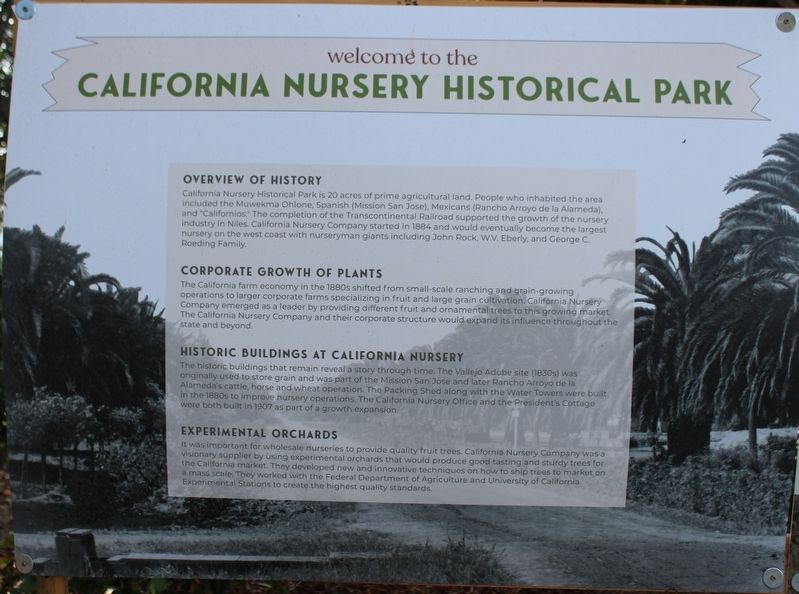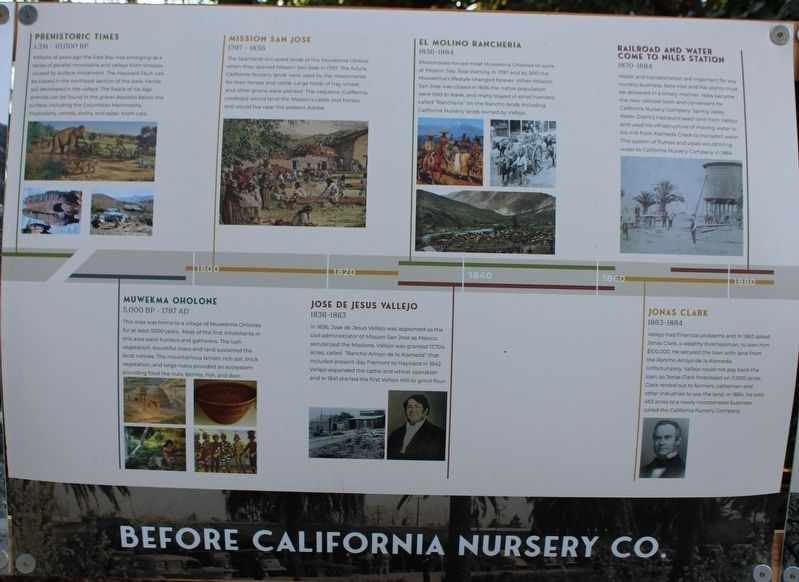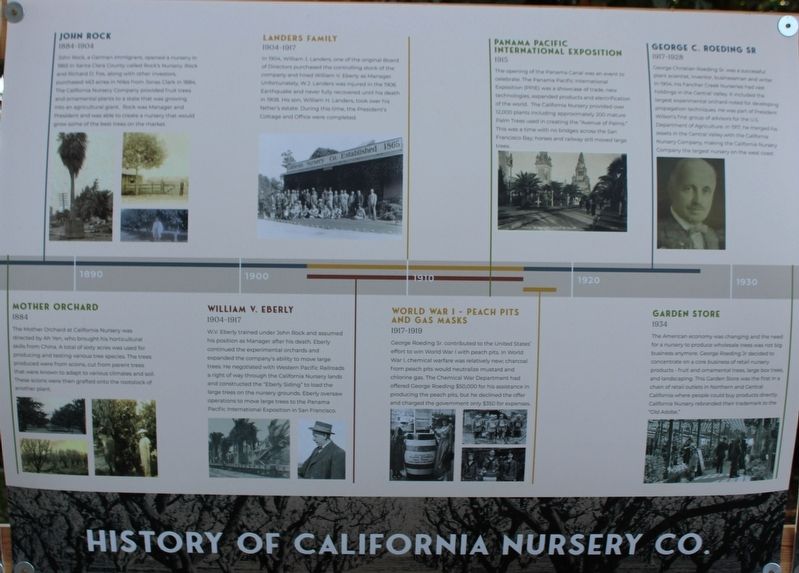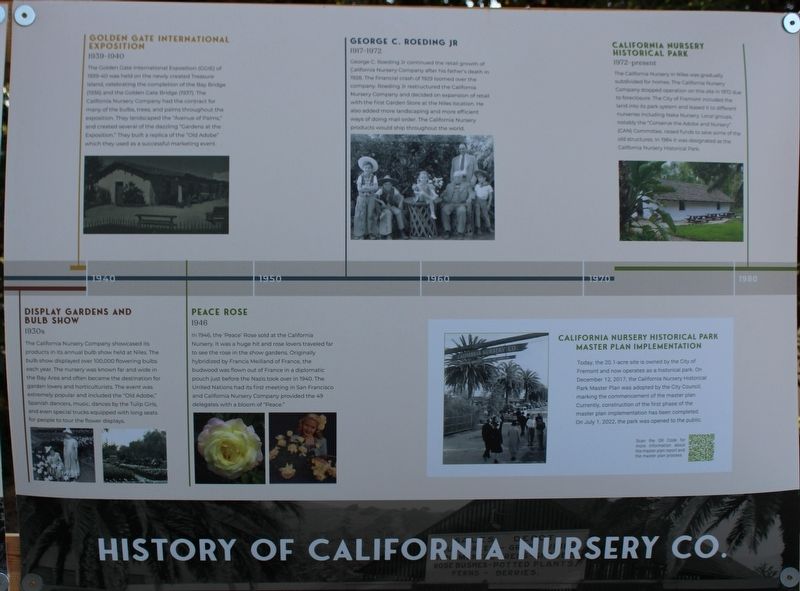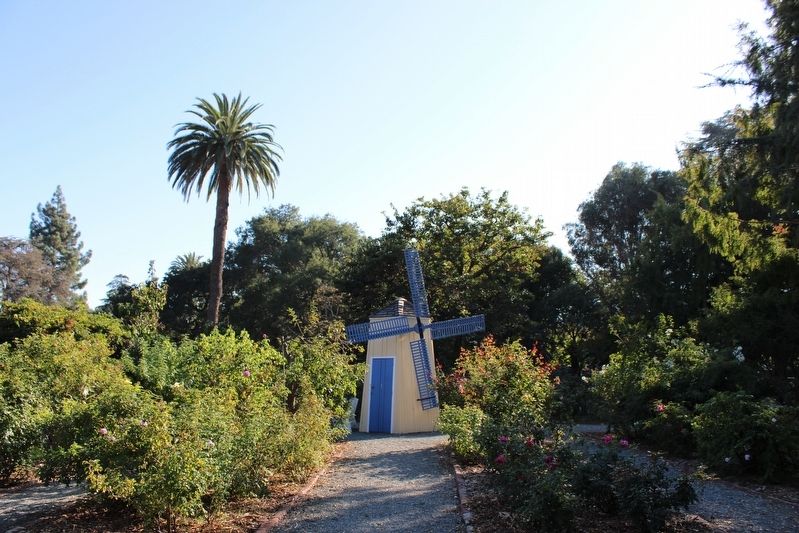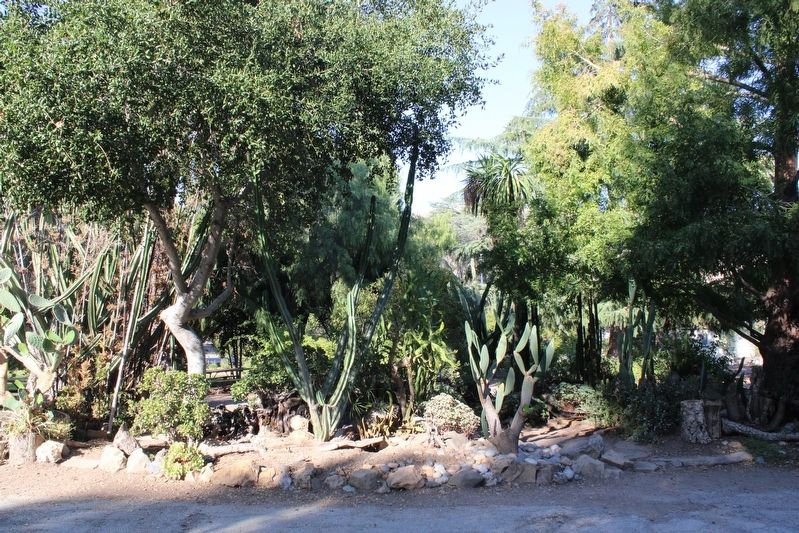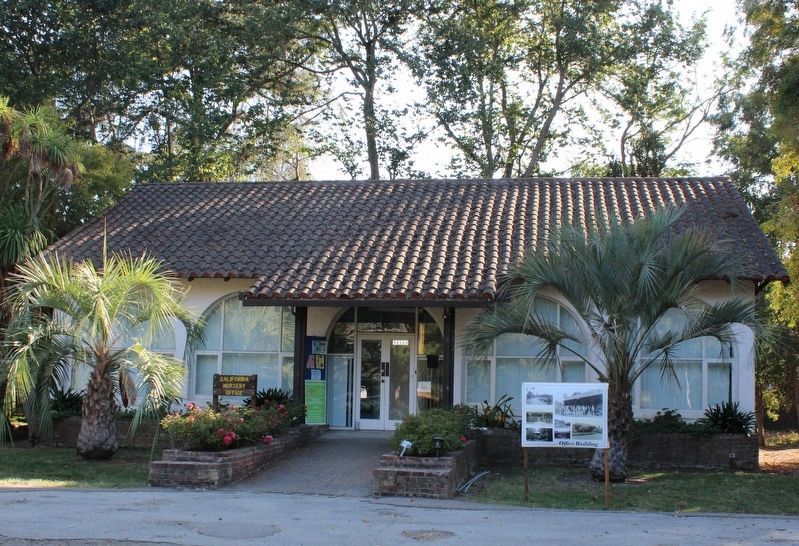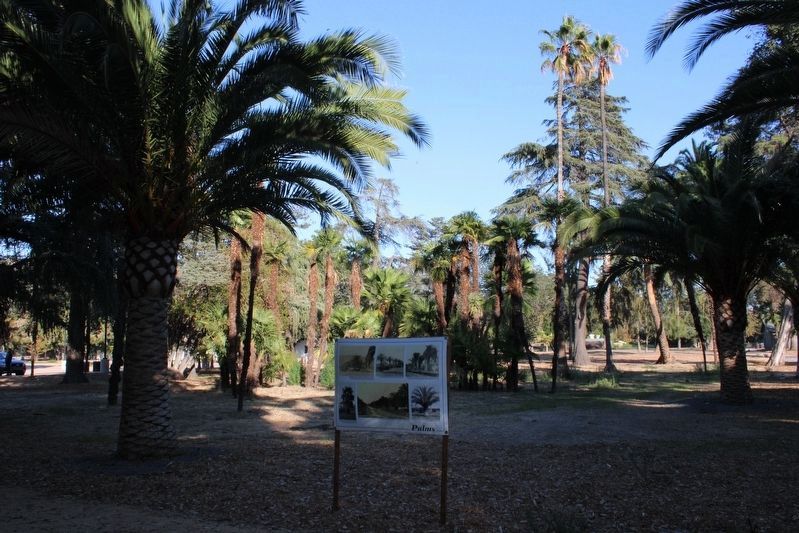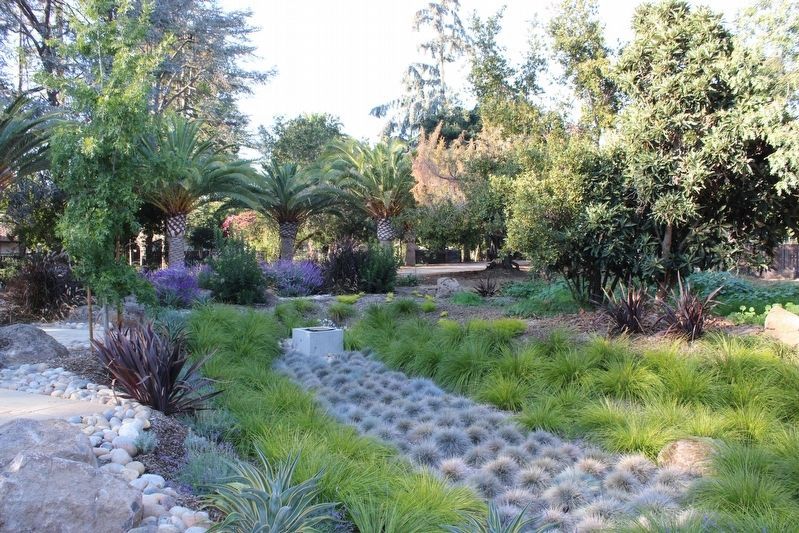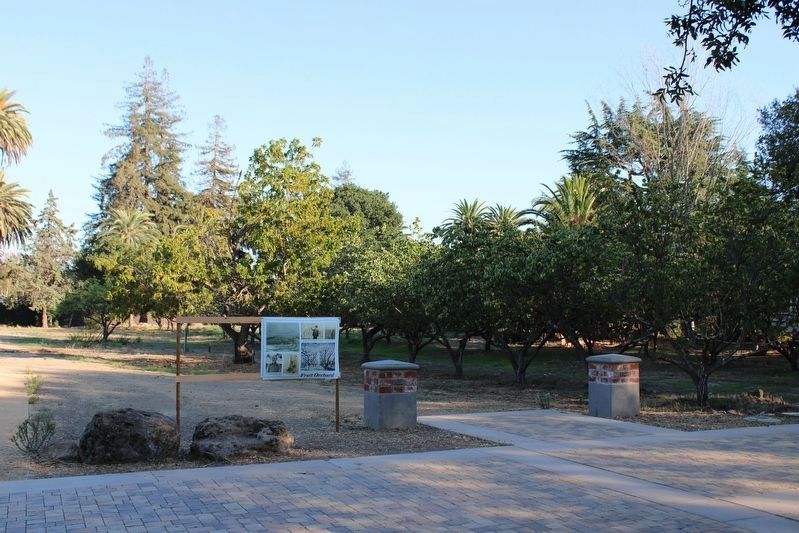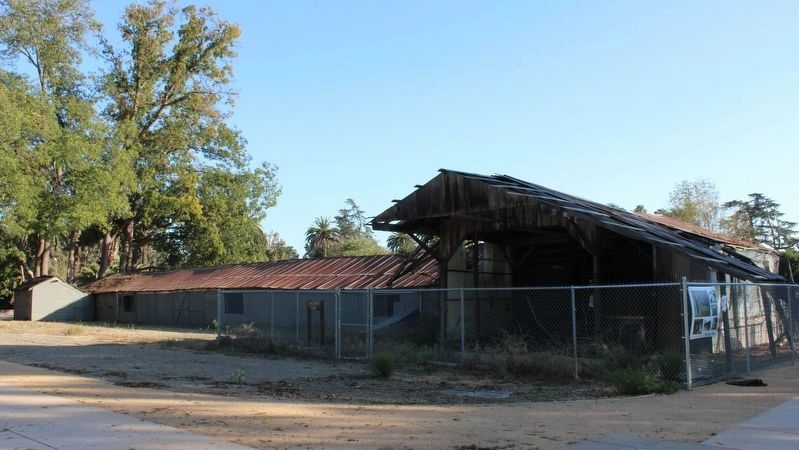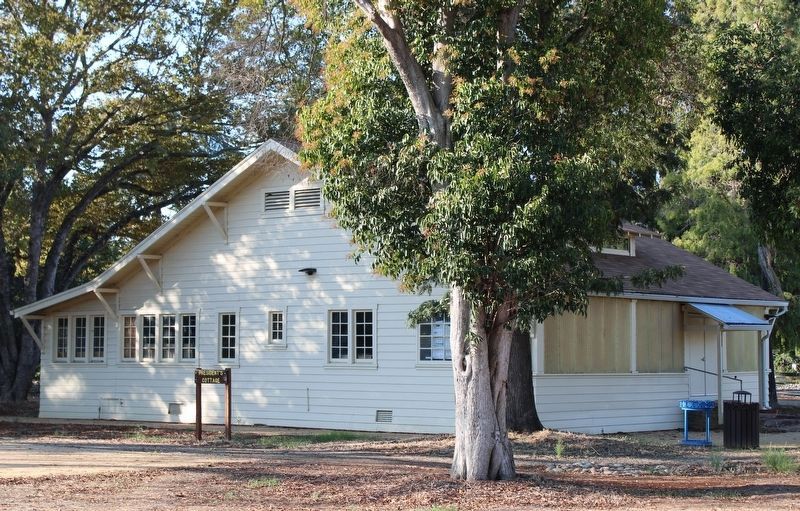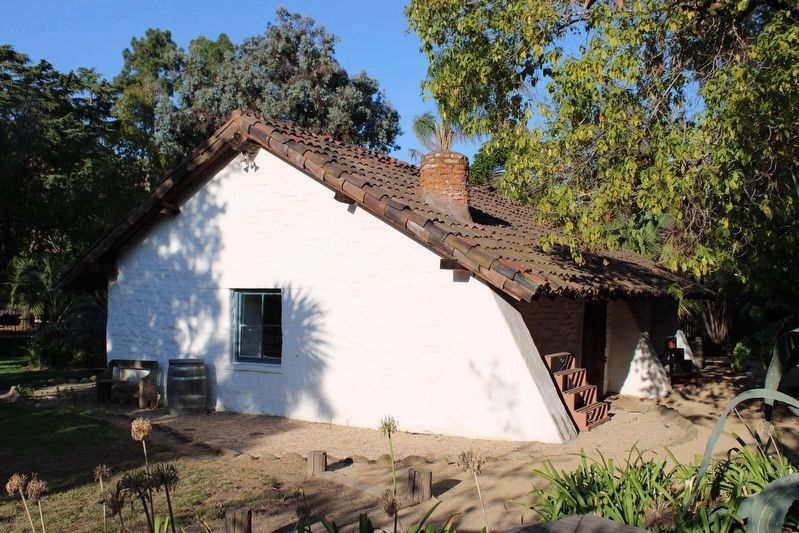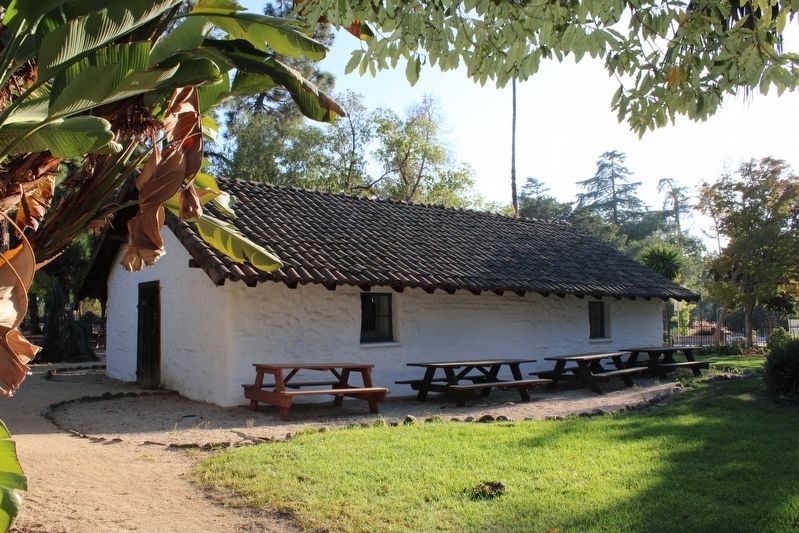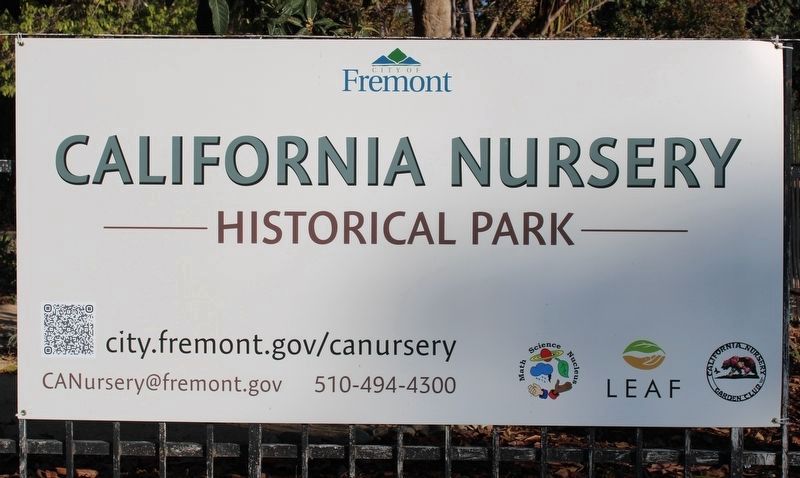Niles in Fremont in Alameda County, California — The American West (Pacific Coastal)
California Nursery Historical Park
California Nursery Historical Park is 20 acres of prime agricultural land. People who inhabited the area included the Muwekma Ohlone, Spanish (Mission San Jose), Mexicans (Rancho Arroyo de la Alameda), and “Californios.” The completion of the Transcontinental Railroad supported the growth of the nursery industry in Niles. California Nursery Company started in 1884 and would eventually become the largest nursery on the west coast with nurserymen giants including John Rock, W.V. Eberly, and George C. Roeding Family.
Corporate Growth of Plants
The California farm economy in the 1880s shifted from small-scale ranching and grain-growing operations to larger corporate farms specializing in fruit and large grain cultivation. California Nursery Company emerged as a leader by providing different fruit and ornamental trees to this growing market. The California Nursery Company and their corporate structure would expand its influence throughout the state and beyond.
Historic Buildings at California Nursery
The historic buildings that remain reveal a story through time. The Vallejo Adobe site (1830s) was originally used to store grain and was part of the Mission San Jose and later Rancho Arroyo de la Alameda’s cattle, horse and wheat operation. The Packing Shed along with the Water Towers were built in the 1880s to improve nursery operations. The California Nursery Office and the President’s Cottage were both built in 1907 as part of a growth expansion.
Experimental Orchards
It was important for wholesale nurseries to provide quality fruit trees. California Nursery Company was a visionary supplier by using experimental orchards that would produce good tasting and sturdy trees for the California Market. They developed new and innovative techniques on how to ship trees to market on a mass scale. They worked with the Federal Department of Agriculture and University of California Experimental Stations to create the highest quality standards.
Prehistoric Times 1.3M – 10,000 BP
Millions of years ago the East Bay was emerging as a series of parallel mountains and valleys from stresses caused by surface movement. They Hayward Fault can be traced in the northeast section of the park. Fertile soil developed in the valleys. The fossils of Ice Age animals can be found in the gravel deposits below the surface, including the Columbian Mammoths, mastodons, camels, sloths, and saber tooth cats.
Muwekma Ohlone 5,000 BP – 1797 AD
This area was home to a village of Muwekma Ohlones for at least 5000 years. Most of the first inhabitants in this area were hunters and gatherers. The lush vegetation, bountiful rivers and land sustained the local natives. The mountainous terrain, rich soil, thick vegetation, and large rivers provided an ecosystem providing food like nuts, berries, fish, and deer…
Mission San Jose 1979 – 1836
The Spaniards occupied lands of the Muwekma Ohlone when they operated Mission San Jose in 1797. The future California Nursery lands were used by the missionaries for their horses and cattle. Large fields of hay, wheat and other grains were planted. The vaqueros (California cowboys) would tend the Mission’s cattle and horses and would live near the present Adobe.
Jose de Jesus Vallejo 1836 – 1863
In 1836, Jose de Jesus Vallejo was appointed as the civil administrator of Mission San Jose as Mexico secularized the Missions. Vallejo was granted 17,704 acres, called “Rancho Arroyo de la Alameda” that included present day Fremont to Hayward in 1842. Vallejo expanded the cattle and wheat operation and in 1841 started the first Vallejo Mill to grind flour.
El Molino Rancheria 1836 – 1884
Missionaries forced most Muwekma Ohlones to work at Mission San Jose starting in 1797 and by 1810 the Muwekma’s lifestyle changed forever. When Mission San Jose was closed in 1836 the native population were told to leave, and many stayed in small hamlets called “Rancheria” on the Rancho lands including California Nursery lands owned by Vallejo.
Jonas Clark 1863 – 1884
Vallejo had financial problems and in 1863 asked Jonas Clark, a wealthy businessman, to loan him $100,000. He secured the loan with land from the Rancho Arroyo de la Alameda. Unfortunately, Vallejo could not pay back the loans, so Jonas Clark foreclosed on 11,000 acres. Clark rented out to farmers, cattlemen and other industries to use the land. In 1884, he sold 463 acres to a newly incorporated business called California Nursery Company.
Railroad and Water Come to Niles Station 1870 – 1884
Water and transportation are important for any nursery business. Bare root and live plants must be delivered in a timely manner. Niles became the new railroad town and convenient for California Nursery Company. Spring Valley Water District had purchased land from Vallejo and used his infrastructure of moving water to his mill from Alameda Creek to transport water. This system of flumes and pipes would bring water to California Nursery Company in 1884.
John Rock 1884 – 1904
John Rock, a German immigrant, opened a nursery in 1863 in Santa Clara County called Rock’s Nursery. Rock and Richard D. Fox, along with other investors, purchased 463 acres in Niles from Jonas Clark in 1884. The California Nursery Company provided fruit trees and ornamental plants to a sate that was growing into an agricultural giant. Rock was manager and President and was able to create a nursery that would grow some of the best trees on the market.
Mother Orchard 1884
The Mother Orchard at California Nursery was directed by Ah Yen, who brought his horticultural skills from China. A total of sixty acres was used for producing and testing various tree species. The trees produced were from scions, cut from parent trees that were known to adapt to carious climates and soil. These scions were then grafted onto the rootstock of another plant.
Landers Family 1904 – 1917
In 1904, William J. Landers, one of the original Board of Directors purchased the controlling stock of the company and hired William V. Eberly as Manager. Unfortunately, W.J. Landers was injured in the 1906 Earthquake and never fully recovered until his death in 1908. Hi son, William H. Landers, took over hos father’s estate. During this time, the President’s Cottage and Office were completed.
William V. Eberly 1904 – 1917
W.V. Eberly trained under John Rock and assumed his position as Manager after his death. Eberly continued the experimental orchards and expanded the company’s ability to move large trees. He negotiated with Western Pacific Railroads a right of way through the California Nursery lands and constructed the “Eberly Siding” to load the large trees on the nursery grounds. Eberly oversaw operations to move large trees to the Panama Pacific International Exposition in San Francisco.
World War I – Peach Pits and Gas Masks 1917 – 1919
George Roeding Sr. contributed to the Unites States’ effort to win World War I with peach pits. In World War I, chemical warfare was relatively new; charcoal from peach pits would neutralize mustard and chlorine gas. The Chemical War Department had offered George Roeding $50,000 for his assistance in producing the peach pits, but he declined the offer and charged the government only $350 for expenses.
Panama Pacific International Exposition 1915
The opening of the Panama Canal was an event to celebrate. The Panama Pacific International Exposition (PPIE) was a showcase of trade, new technologies, expanded products and electrification of the world. The California Nursery provided over 12,000 plants including approximately 200 mature Palm Trees used in creating the “Avenue of Palms.” This was a time with no bridges across the San Francisco Bay, horses and railway still moved large trees.
George C. Roeding Sr 1917 – 1928
George Christian Roeding Sr. was a successful plant scientist, inventor, businessman and writer. In 1904, his Francher Creek Nurseries had vast holdings in the Central Valley. It included the largest experimental orchard noted for developing propagation techniques. He was part of President Wilson’s first group of advisors for the U.S. Department of Agriculture. In 1917, he merged his assets in the Central Valley with the California Nursery Company, making the California Nursery Company the largest nursery on the west coast.
Garden Store 1934
The American economy was changing and the need for a nursery to produce wholesale trees was not big business anymore. George Roeding Jr decided to concentrate on a core business of retail nursery products – fruit and ornamental trees, large box trees, and landscaping. This Garden Store was the first in a chain of retail outlets in Northern and Central California where people could buy products directly. California Nursery rebranded their trademark to the “Old Adobe.”
Display Gardens and Bulb Show 1930s
The California Nursery Company showcased its products in its annual bulb show held at Niles. The bulb show displayed over 100,000 flowering bulbs each year. The nursery was known far and wide in the Bay Area and often became the destination for garden lovers and horticulturists. The event was extremely popular and included the “Old Adobe,” Spanish dancers, music, dances by the Tulip Girls, and even special trucks equipped with long seats for people to tour the flower displays.
Golden Gate International Exposition 1939 – 1940
The Golden Gate International Exposition (GGIE) of 1939-40 was held on the newly created Treasure Island, celebrating the completion of the Bay Bridge (1936) and the Golden Gate Bridge (1937). The California Nursery Company had the contract for many of the bulbs, trees, and palms throughout the exposition. They landscaped the “Avenue of Palms,” and created several of the dazzling “Gardens at the Exposition.” They built a replica of the “Old Adobe” which they used as a successful marketing event.
Peace Rose 1946
In 1946, the ‘Peace Rose’ sold at the California Nursery. It was a huge hit and rose livers traveled far to see the rose in the show gardens. Originally hybridized by Francis Meilland of France, the budwood was flown out of France in a diplomatic pouch just before the Nazis took over in 1940. The United Nations had its first meeting in San Francisco and California Nursery Company provided the 49 delegates with a bloom of “Peace.”
George C. Roeding Jr 1917 – 1972
George C. Roeding Jr continued the retail growth of California Nursery Company after his father’s death in 1928. The financial crash of 1929 loomed over the company. Roeding Jr restructured the California Nursery Company and decided on expansion of retail with the first Garden Store at the Niles location. He also added more landscaping and more efficient ways of doing mail order. The California Nursery products would ship throughout the world.
California Nursery Historical Park 1972 – Present
The California Nursery in Niles was gradually subdivided for homes. The California Nursery Company stopped operation on this site in 1972 due to foreclosure. The City of Fremont included the land into its park system and leased it to different nurseries including Naka Nursery. Local groups, notably the “Conserve the Adobe and Nursery” (CAN) Committee, raised funds to save some of the old structures. In 1984 it was designated as the California Nursery Historical Park.
California Nursery Historical Park Master Plan Implementation
Today, the 20.1 acre site is owned by the City of Fremont and now operates as a historical park. On December 12, 2017, the California Nursery Historical Park Master Plan was adopted by the City Council, marking the commencement of the master plan. Currently, construction of the first phase of the master plan implementation has been completed. On July 1, 2022, the park was opened to the public.
Topics. This historical marker is listed in these topic lists: Anthropology & Archaeology • Horticulture & Forestry • Native Americans • Railroads & Streetcars. A significant historical year for this entry is 1884.
Location. 37° 34.687′ N, 121° 59.483′ W. Marker is in Fremont, California, in Alameda County. It is in Niles. Marker can be reached from Nursery Avenue near Niles Avenue. The marker is near the southwest corner of the main parking lot. Touch for map. Marker is at or near this postal address: 36501 Niles Boulevard, Fremont CA 94536, United States of America. Touch for directions.
Other nearby markers. At least 8 other markers are within walking distance of this marker. Legendary Nursery Innovators (about 500 feet away, measured in a direct line); California Nursery Historical Park Master Plan (about 500 feet away); Gardens, Orchards & Plants (about 500 feet away); Boxed Tree Forest and Fruit Tree Orchard (about 500 feet away); The Garden Store (about 500 feet away); Buildings & Structures (about 500 feet away); Essanay Film Studio (approx. half a mile away); Essanay Studio Site (approx. 0.6 miles away). Touch for a list and map of all markers in Fremont.
Also see . . . California Nursey Company Legacy Council.
”The California Nursery Co., founded in 1865 by John Rock, was originally located at Wayne Station in San Jose. It relocated to Niles, CA (Fremont) in 1884 and incorporated. The Nursery was purchased by George C. Roeding of Fresno in 1917 and has been in the family ever since.”(Submitted on October 27, 2022, by Joseph Alvarado of Livermore, California.)
Credits. This page was last revised on February 7, 2023. It was originally submitted on October 27, 2022, by Joseph Alvarado of Livermore, California. This page has been viewed 476 times since then and 123 times this year. Photos: 1, 2, 3, 4, 5, 6, 7, 8, 9, 10, 11, 12, 13, 14, 15. submitted on October 27, 2022, by Joseph Alvarado of Livermore, California.
